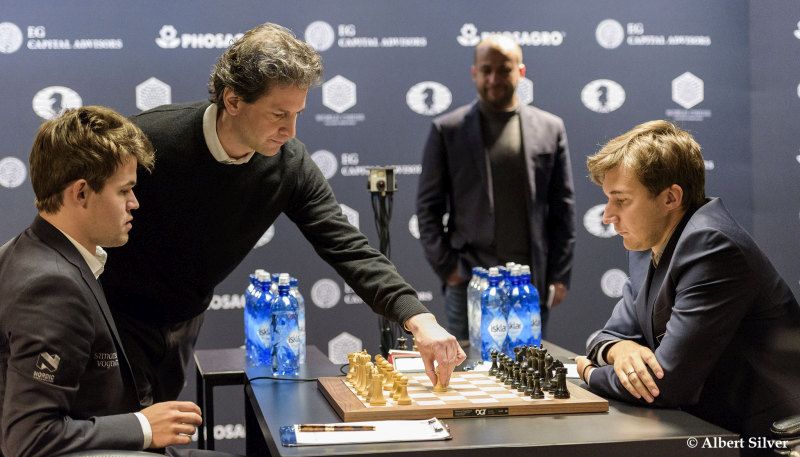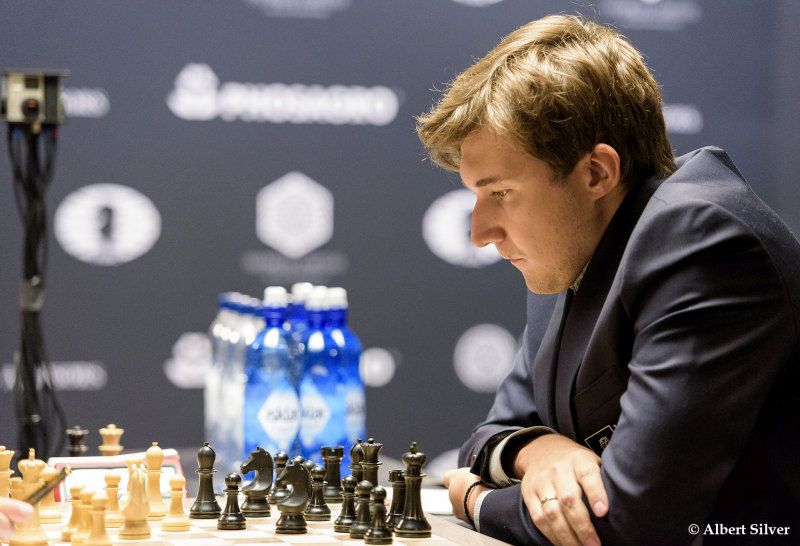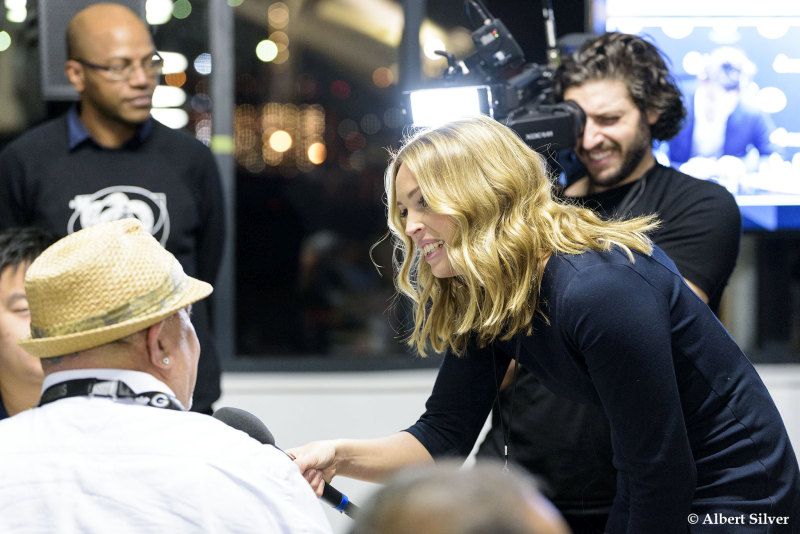FWCM 05: A perfect draw!
After three games in the Ruy Lopez/Berlin territory, Magnus Carlsen decided that it was time to bring in the Guioco Piano. The game witnessed an unusual move order which soon resulted in a fresh position. Karjakin was upto the task today as he kept control. Towards move 40, Magnus began to lose the control of the game and slid into a worse position. Being in a territory that he has never been in, Karjakin couldn't press in the best possible manner and the game ended in a draw. We have pictures, game analysis and key positions for you.
Pictures by Albert Silver
FWCM 05: A draw in the Guioco Piano

In games three and four it was clear that Magnus was pushing. Many chess fans predicted a Carlsen win in the fifth round with the white pieces. However, Karjakin came up with all the goods to draw the game without any real difficulty. In fact the Russian had some chances to press for an advantage towards the end.
This World Championship is turning out to be much more keenly contested than what the experts thought. Magnus is unable to convert his advantage and Karjakin is holding his own in complex middlegame fights. It might well be that Sergey senses his opportunity and goes for the kill in the sixth round. But before that let's have a look at some key moments in the fifth game.
Key moments in the game
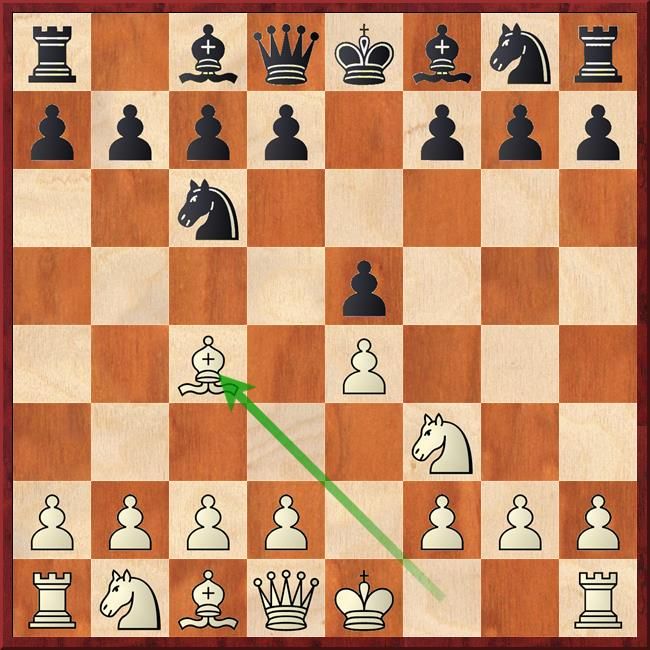
Seeing the Guioco Piano no longer comes as a surprise because it has been played extensively at the top level. In any case, it was a welcome change from the Ruy Lopez and Berlin territory.

...Nxe4 by Karjakin was a strong move. It's a common idea in the Pirc and many other openings. Of course, Magnus had seen that such a sacrifice followed by the pawn fork d5 was possible, but he assessed the resulting position in White's favour. Sergey thought Black was doing fine. It was an interesting moment of the game. Objectively the position is around even.
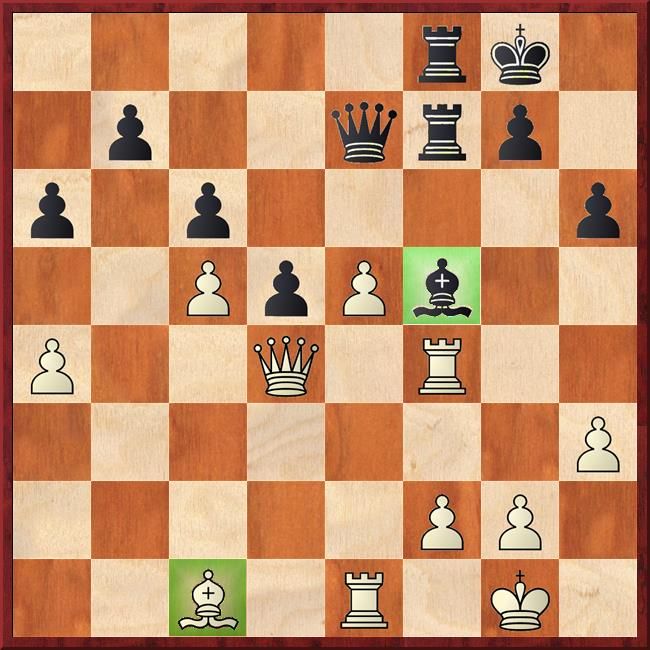
Soon we reached an opposite coloured bishop position in which both the bishops were quite good. Black's queenside majority had been blocked for good. So it seemed as if White had the advantage as he had a 4 vs 2 majority on the other wing. However, to move your pawns in front of the king is never easy and it was not possible for Magnus to mobilize his pawns.
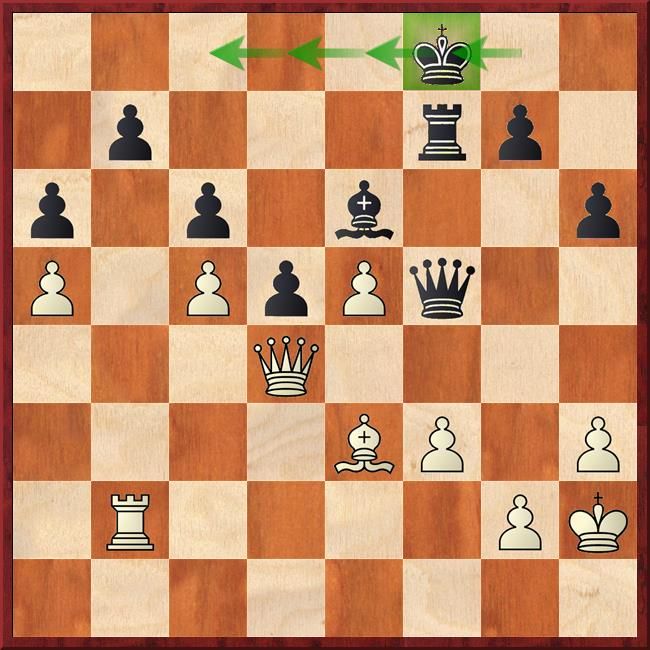
An excellent decision by Sergey. He moved his kingside out of the war zone and brought it to safety on c8. This also ensured that the b7 pawn was defended. Once this plan was found, Black was in no real difficulty.
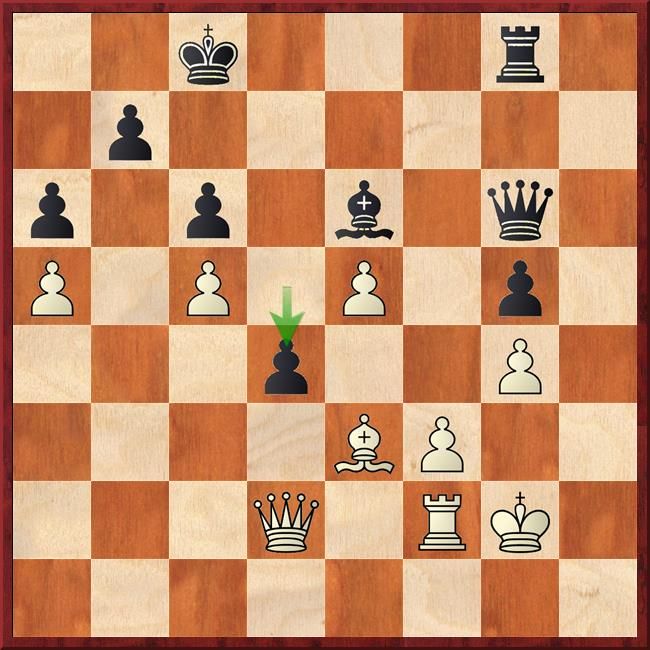
Karjakin knows his basics! Carlsen lost the thread of the game and allowed the Russian to sacrifice a pawn and activate his bishop. Sergey did just that with ...d4! and ...Bd5. He could have pressed on in the position had he got his king to safety with Kb8-a7. However, Sergey didn't play in the most precise fashion, and the game ended in a draw.
[Site "New York"]
[Date "2016.11.17"]
[Round "5"]
[White "Carlsen, Magnus"]
[Black "Karjakin, Sergey"]
[Result "1/2-1/2"]
[ECO "C54"]
[WhiteElo "2857"]
[BlackElo "2769"]
[Annotator "Sagar Shah"]
[PlyCount "102"]
[EventDate "2016.??.??"]
[EventType "match"]
[EventCountry "USA"]
[SourceTitle "playchess.com"]
[Source "ChessBase"]
[TimeControl "40/6000+30:20/3000+30:900+30"]
didn't opt for a Ruy Lopez after the moves 1.e4 e5 2.Nf3 Nc6. Magnus had got
an advantage in the Berlin with the benign 5.Re1 but decided that Guioco Piano
was a much better attempt for an advantage.} Bc5 {5} 4. O-O {0 c3 is the most
popular move order. However, Magnus doesn't always like to go down the road
that has been visited often.} Nf6 {5} 5. d3 {0} O-O {7} 6. a4 $5 {13 This move
gains space and in general is followed up with the moves c3 and b4.} (6. h3 {
is the new favourite of many players. Kramnik beat Anand by using it at the
Tal Memorial.}) 6... d6 {43} 7. c3 {33 Whenever d6 and 0-0 have been played by
Black, I am always apprehensive about the move Bg5. How to get rid of the pin?}
(7. Bg5 h6 8. Bh4 g5 9. Nxg5 hxg5 10. Bxg5 {This doesn't quite work because
the bishop on c5 prevents White from going f4. And in general it is not so
easy to strengthen the position.} Kg7 11. Kh1 Rh8 12. f4 Rxh2+ $1 13. Kxh2 Qh8+
14. Kg3 exf4+ 15. Rxf4 Nh5+ $19 {is just an illustrative variation of how
Black can win the game.}) 7... a6 {7} 8. b4 {21} Ba7 {21} 9. Re1 $146 {6 This
is the first new move of the game.} Ne7 {139 The transfer of the knight from
c6 to g6 is a very common theme in this opening.} 10. Nbd2 {68} Ng6 {50} 11. d4
{81 Black looks much more harmoniously developed. However, White has the
center. The position is round about even.} c6 {431 Black's idea with the move
c6 is clear. He would like to take on d4 followed by Nxe4 and the d5 pawn fork.
} 12. h3 {194} (12. Bb3 Re8 13. h3 Be6 {Overall the position is quite pleasant
for Black. One of the things that White would like to do is transfer the
knight from d2-f1-g3. But this is not so easy as the e4 pawn is always under
pressure.}) 12... exd4 {1070} 13. cxd4 {13} Nxe4 $5 {497} 14. Bxf7+ {525
Usually giving up the bishop in this fashion is not a good idea. You not only
lose the bishop pair, but also give your opponent a strong centre. Magnus,
however, has seen deeper.} (14. Nxe4 d5 15. Bd3 {would be the most natural way
to play, preserving the bishop.} dxe4 16. Bxe4 {White has a big threat of
playing b5 and opening up the queenside. Black cannot really do much about it.}
Be6 17. b5 Bd5 18. bxa6 bxa6 19. Rb1 $14 {Black is solid, but it goes without
saying that White is slightly better.}) 14... Rxf7 {15} 15. Nxe4 {10} d5 {217}
16. Nc5 {937 This is Carlsen's idea. The knight is extremely well placed on c5
and it greatly limits the scope of both the bishops: a7 is blocked and c8
needs to constantly look after b7. At the same time taking the knight would
not be a great idea, as after a move like dxc5 White would have a clear edge.}
h6 {312} 17. Ra3 {93 There is no way to determine which is the most useful
square for the bishop on c1. But we know that the rook would be great on
squares like e3 or g3.} Bf5 {160} 18. Ne5 {1262} (18. Rae3 Qf8 (18... Bxc5 19.
dxc5 Be4 20. Nd4 Nf4 21. Rg3 Qh4 22. Bxf4 Qxf4 23. Re2 $14 {is a very pleasant
edge for White.}) 19. Qb3 Kh7 20. Ne6 Bxe6 21. Rxe6 {White looks to be
pressing in this position.} Rxf3 22. Qxf3 Qxf3 23. gxf3 Bxd4 {is an
interesting exchange sacrifice, but it falls short as after} 24. Re8 $1 $16 {
The rooks are exchanged and White keeps the edge.}) 18... Nxe5 {37} 19. dxe5 {
51} Qh4 {1586} 20. Rf3 {971} Bxc5 {327} (20... Qxb4 $2 21. Ba3 $1 Qh4 22. e6
Rf6 23. Nd7 $18 {The rook is lost.}) 21. bxc5 {2 We now have an interesting
opposite coloured bishop scenario where Black's pawn structure is much more
compact, but White has space and the passed e-pawn.} Re8 {8 It was important
to block the advance of the e-pawn.} 22. Rf4 {88} Qe7 {25} 23. Qd4 {46 White
starts his dark squared dominance.} Ref8 {33} 24. Rf3 {233 Now Magnus would
like to give back the pawn with e6 and shift his rook to g3. In this way he
would have excellent compensation in the opposite coloured bishop endgame.} (
24. e6 Bxe6 {And there are no real tricks. Black is fine.} 25. Rg4 Bxg4 26.
Rxe7 Rxe7 27. hxg4 Re1+ $19) 24... Be4 {332} (24... -- 25. e6 Bxe6 26. Rg3) 25.
Rxf7 {154} (25. Rg3 Rxf2 26. Qxf2 Rxf2 27. Kxf2 Qxe5 $19) 25... Qxf7 {17} 26.
f3 {70} Bf5 {7} 27. Kh2 $1 {237 A huge threat awaits Black - the white pawn
avalanche starting with the moves g4 and f4 and f5. Black must do something
about it.} Be6 {82} 28. Re2 {114 Just probing Black.} (28. f4 h5 {keeps things
under control.}) 28... Qg6 {96} 29. Be3 {67} Rf7 {92} 30. Rf2 {71} Qb1 {122}
31. Rb2 {364} Qf5 {141} 32. a5 {210} Kf8 $5 {132 The king plans to go to c8.
In this way, he would not only be safe from the attack but also defend the b7
pawn.} 33. Qc3 {37} Ke8 {328} 34. Rb4 {37} g5 {160} 35. Rb2 {179} Kd8 {33} 36.
Rf2 {24} Kc8 {75} 37. Qd4 {51} (37. f4 g4 $15) 37... Qg6 {74} 38. g4 {167} h5 {
56 In general White cannot really hope for much because he always has to take
care about his king on h2.} 39. Qd2 {62} Rg7 {215} 40. Kg3 {0} Rg8 {175} 41.
Kg2 $6 {665} (41. Qd4 {It was better to keep the d4 square blocked and accept
a draw. Magnus tries to fool around, but Sergey is alert.}) 41... hxg4 {446}
42. hxg4 {30} d4 $1 {231 Excellent decision. By giving the pawn up, Black
activates the bishop. As we all know, in opposite coloured bishops scenarios
it is much more important to have an active bishop than an extra pawn.} 43.
Qxd4 {577} Bd5 {511} 44. e6 {378} Qxe6 {52} (44... Qh7 45. e7 Qxe7 {would
nearly transpose to the same thing.}) 45. Kg3 {122} Qe7 {43} (45... Kb8 {
Getting the king to a8 and then continuing the attack was also a sound idea.}
46. Rh2 Ka7 {Now White has to be careful as exchanging the queens is nearly
impossible and the white king is much weaker than its counterpart.}) 46. Rh2 {
208} Qf7 {548} 47. f4 $1 {14 This ensures that the queens are exchanged and
the game ends in a draw.} gxf4+ {4} 48. Qxf4 {26} Qe7 {200} 49. Rh5 {179} Rf8 {
544} (49... Re8 50. Qf5+ Kb8 51. Qe5+ $1 Qxe5+ 52. Rxe5 Rxe5 53. Bf4 $11) 50.
Rh7 {214} Rxf4 {23} 51. Rxe7 {9} Re4 {4} (51... Re4 52. Rxe4 Bxe4 53. Kf4 Bd3
54. Ke5 {This position is drawn because Black will just bring his king to e8.
The g-pawn is going nowhere and even if White manages to win the b7 pawn, the
bishop on b5 would control everything.} Bc2 (54... Kb8 $2 55. Kf6 Ka8 56. g5
Bc2 57. g6 Bxg6 58. Kxg6 Ka7 59. Kf7 Ka8 60. Ke7 Ka7 61. Kd7 Ka8 62. Kc8 Ka7
63. Bf4 Ka8 64. Bb8 $1 $18) 55. Kf6 Kd7 56. g5 Bd3 57. g6 Ke8 $11) 1/2-1/2
